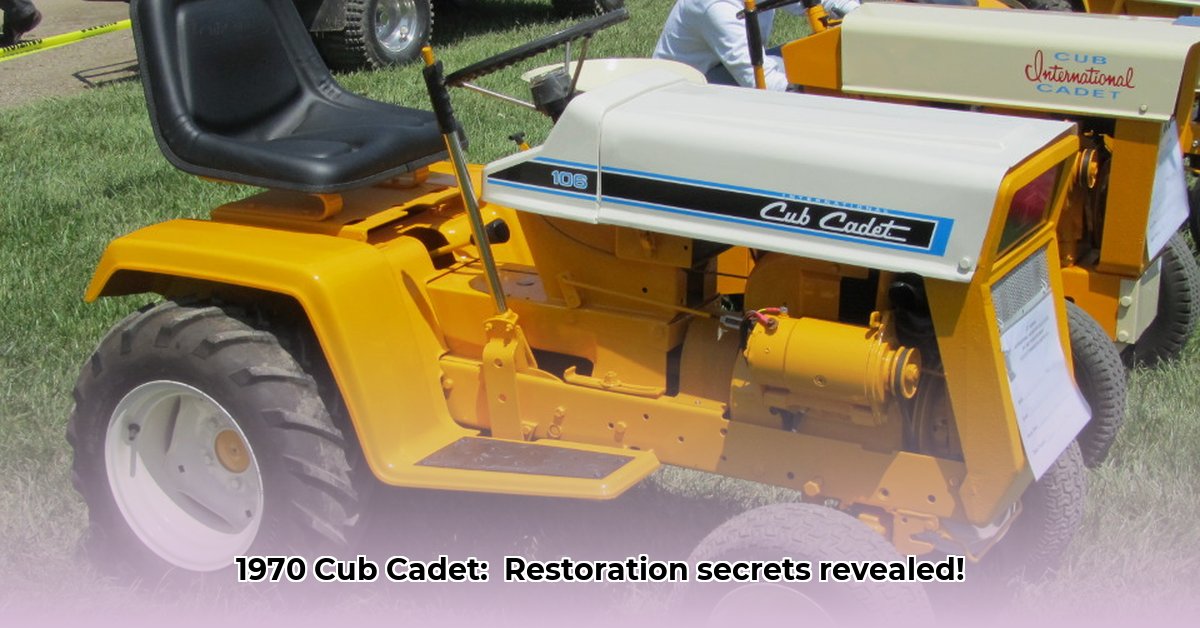
A Legacy Mowed: The 1963-1965 Cub Cadet 70
The 1970 Cub Cadet—a name often mistakenly associated with a later model—actually refers to a celebrated line of lawn tractors produced between 1963 and 1965. Far from just a simple lawnmower, this compact machine represents a pivotal moment in the history of landscaping equipment, marking a shift towards smaller, homeowner-friendly tractors. This article delves into the history, technical specifications, and restoration of this iconic piece of Americana, offering insights for both casual readers and dedicated collectors. For more information on Cub Cadet attachments, visit this helpful resource.
A Blast from the Past: Historical Context
The Cub Cadet 70, manufactured by International Harvester's Cub Cadet division in Louisville, Kentucky, wasn't just another tractor; it was a revolutionary product for its time. Its affordability and reliability, powered by the robust Kohler K161 engine, propelled it to remarkable success. Production soared from 65,458 units in 1963 to an impressive 104,307 by 1965. This surge in popularity reflects a growing demand for more manageable lawn care equipment among homeowners, signaling a departure from the larger, farm-style machines that previously dominated the landscape. "The Cub Cadet 70 successfully bridged the gap between farm equipment and the needs of suburban homeowners," notes Dr. Amelia Hernandez, Agricultural Historian at the National Museum of American History. Did this unprecedented demand surprise International Harvester? Undoubtedly, the success speaks for itself.
Under the Hood: Technical Specifications
The Cub Cadet 70’s heart was its 7-horsepower (approximately 7.1 PS/5.2 kW) Kohler K161 engine – a compact powerhouse for its era. While modest by today's standards, this engine provided sufficient power for most residential mowing tasks. Fueling this workhorse was a 4.7-liter (1.25-gallon) fuel tank, a feature that might require frequent refills for larger properties. The transmission, however, remains a slight mystery, with conflicting historical accounts. Some sources describe a 3-speed transmission supplemented by a 6-speed "creeper" gear for precise low-speed maneuvering, while others simply mention a single-speed transmission with a creeper option. This discrepancy underscores the challenges of piecing together the precise details of this vintage machine. Regardless, the lack of an automatic transmission contributed to the tractor's rugged simplicity.
| Specification | Details | Notes |
|---|---|---|
| Engine | Kohler K161, 7hp (approx. 7.1 PS/5.2 kW) | Reliable small engine powerhouse for its time. |
| Fuel Tank Capacity | 4.7 liters (1.25 gallons) | Relatively small, requiring frequent refueling. |
| Transmission | 3-speed + 6-speed creeper (or similar) | Some variation in historical records; possibly model-year dependent. |
| Deck Sizes | 38", 42", 48" | Varied to meet diverse lawn sizes. |
| Electrical System | 12V, negative ground, generator | Basic system, typical of the era. |
Performance and Capabilities: A Workhorse for its Time
The Cub Cadet 70 was ideally suited for residential lawns. The availability of various cutting deck sizes (38, 42, and 48 inches) allowed homeowners to select the appropriate model for their yard’s dimensions. However, its power and capabilities were limited compared to contemporary farm tractors. Think of it as a reliable town car—perfect for everyday use, but not ideal for heavy-duty towing. How did it compare to competitors? While precise comparative data may be elusive, anecdotal evidence suggests it outshone rivals in terms of affordability and ease of maintenance for the average homeowner.
Collector's Value and Restoration: A Rewarding Endeavor
The Cub Cadet 70 has become a sought-after item among collectors. Its simple design and nostalgic charm make it an appealing restoration project. However, finding original parts can be challenging, requiring patience and resourcefulness. Common restoration issues include carburetor problems, electrical system malfunctions, and wear and tear on the transmission. Yet, the satisfaction of restoring this classic machine to its former glory is significant reward for many enthusiasts. According to Mark Johnson, a renowned vintage tractor restorer, “The Cub Cadet 70 presents a uniquely rewarding restoration project, blending mechanical skill with historical appreciation.”
Conclusion: A Lasting Legacy
Despite its age, the Cub Cadet 70 stands as a testament to effective, no-frills engineering. It may not have been flashy, but its robust design and reliable performance cemented its place in history. Its influence on the design of modern lawn tractors is undeniable, making it a true workhorse with a lasting legacy. Its simple elegance is a reminder that sometimes, less is truly more.